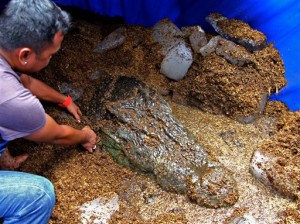‘Lolong’ tissues sent to UP
MANILA, Philippines—Tissue samples of Lolong, the saltwater crocodile which died early this week, have been sent to the University of the Philippines in Los Banos (UPLB) for analysis.
Protected Animals and Wildlife Bureau (PAWB) chief Dr. Mundita Lim said a specimen was forwarded to the UPLB College of Veterinary Medicine in Laguna the other day.
“We are meeting with the team to analyze the findings. We will discuss what is available and we will see if we can derive a conclusion from there,” she said in a text message.
Lolong, a one-ton crocodile captured in 2011, died on Sunday at an eco-tourism park in Bunawan, Agusan del Sur.
The PAWB said it would conduct a necropsy to determine the cause of death of the 5.48 meter long crocodile, which was touted as the world’s largest crocodile.
Article continues after this advertisementDr. Em Lastica of the UPLB College of Veterinary Medicine said the process of analysing Lolong’s tissue sample—or histopathology—will take about two weeks.
Article continues after this advertisement“We will process the tissues so that we can look at them in detail to confirm or negate our findings on the carcass… The result is a miniature section of the organ which we can look under the microscope,” Lastica said.
After the analysis, a meeting will be called by the PAWB to discuss the results.
Lolong was estimated to be around 60 years old at the time of his death. He was captured on Sept. 3, 2011, in a river in Bunawan after reports of a death of a child and a fisherman gone missing.
He was cared for at an eco-park in Bunawan for one year and four months, becoming a tourist attraction until his death on Sunday evening.
